Setting A Precedent Takes Courage: Directing the first bilingual production at a PWI by Sylvia Cervantes Blush
Producing comedias is often a challenging discussion amongst my Latiné community because of the irreparable harm brought on by Spanish colonialism, especially when producing them at predominately white institutions (PWIs). Yet by not doing them we are silencing the collection of progressive works by artists like Ana Caro, who challenged political agendas, religious ideologies, and societal norms and whose plays encourage present-day artists and patrons to look inward for personal and communal change. So, when Professor Margaret E. Boyle (specialist in Hispanic women’s literature and comedia history) invited me to work with her and her colleagues Professor Ireri Chávez-Bárcenas (musicologist in the early modern period) and Professor Germán Cárdenas-Alaminos (scenic designer) on Valor, agravio y mujer, the first bilingual theatrical production in Bowdoin College’s 230-year history, I couldn’t say yes fast enough. Their passion and kindness jumped beyond the Zoom screen with a joyous welcoming spirit that promised a rewarding creative adventure.
Diversifying the Classics’ translation (The Courage to Right a Woman’s Wrongs) was where we started because it richly retains the integrity of Ana Caro’s poetry, comedy, and symbolism, while offering accessible language ripe for performance. We did however go with a more literal title translation of Valor, Outrage and Woman. Margaret and I injected commonly used words and phrases from the original Spanish to give both actors and audiences a taste of Caro’s magic. We had a contingency plan of performing the text entirely in English if we didn’t have enough native Spanish speakers cast in the production, but fortune was on our side. Not only did we have a cast able to handle the original text, we also had Anny Vergara, a Teaching Fellow from Colombia, who volunteered to coach students who needed support with pronunciation.
Having all of these collaborators in place made it clearer to us that the viability of Spanish Golden Age comedias in an academic setting is less about selecting only BIPOC or native Spanish-speaking actors and more about building community through Ana Caro’s themes of personhood, gender, and courage, as well as sharing that with the greater audience. I used her work to normalize conversations on colonization, appropriation, gender fluidity, intimacy and boundaries in theater practices. The students at Bowdoin are bold and in many ways leading the charge in these conversations, but if PWIs are looking for equitable ways to include all voices in the theater canon then they must break down the hold Shakespeare has as the main gatekeeper of classical works. The Bard’s contemporaries across the globe, like Caro, were creating profound narratives of their own and female-identifying writers in Spain were not only performing, unlike on Shakespeare’s stages, but were also writing and even making a living off their work. This was just as exciting to me as directing the first bilingual production for Bowdoin.
Every time I shared with someone what brought me to Maine, I got to tell them about Ana Caro and how with Valor she was bending the Don Juan myth, elevating the heroine’s agency and, through the servants, making it known that women were and had been creating different forms of literature for centuries. So, when it came to deciding on supertitles for the show, I opted to forgo them because I wanted to challenge the myth that our non-Spanish speaking audience wouldn’t understand phrases not spoken in English. I was interested in leaning into the richness of bilingualism and utilizing universal forms of communication. I turned to physical gestures to demonstrate emotional arcs, stage pictures to highlight status between characters, and sound design to support sweeping romantic passages, comedic entanglements, or dramatic tension. With the support from Anny, Margaret and Ireri, our cast of ten, from various ethnic demographics, were successful in communicating the heart of Caro’s narrative without appropriating her culture or isolating monolingual theatergoers.
Creative team: Sylvia Cervantes Blush (Director and Sound Design), Germán Cárdenas Alaminos (Scenic), Lily Prentice (Costume), Gregg Carville (Lights), Sally Wood (Fight Choreographer), Ireri Chávez-Bárcenas (Musicologist), Margaret E. Boyle (Dramaturg), Carolyne Sauda (Associate Music Director), Anny Vergara (Language Coach), Grace Keller Long and Meg Lydon (Stage Managers), Deborah Puhl (Technical Director), Jim Alexander (Asst. T.D.), Rani Long (Administrative Assistant), Nicole Boudle (Producing Manager), and Davis Robinson (Theater Chair)
Live music and original composition by La Chimera Ensemble: Carolina Egüez (Vihuela de Gamba), Eduardo Egüez (Lutenist/Guitarist & Artistic Director), Carlotta Pupulin Egüez (Harpist), Sabina Colonna Preti (Vihuela de Gamba), Margherita Pupulin Egüez (Violinist) featuring Nell Snaidas (Soprano)
Cast in alphabetical order: Colette Carrillo (Lisarda), Will Churchill (Don Juan de Córdoba), Louise Cummins (Leonor/ Don Leonardo), Reynaldo Fuentez (Fineo/Rufino), Rickey Karundhara (Ribete), Maddy Kosmoski (Estela, Countess of Sora), Emma Paterson-Dennis (Ludovico, Prince of Pinoy), Luciana Perdomo (Flora/Tibaldo), Harrison Schwartz (Tomillo), Juan Carlos Villa Diaz (Don Fernando de Ribera)
Presented by: Department of Theater and Dance, Department of Music, Department of Latin American, Caribbean and Latinx Studies, Department of Romance Languages and Literatures
Production Photos: Alex Hou



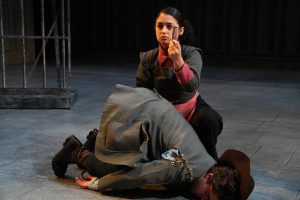
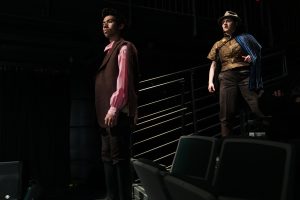
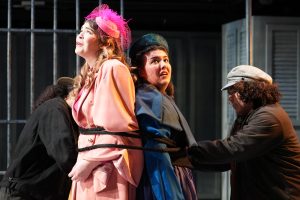
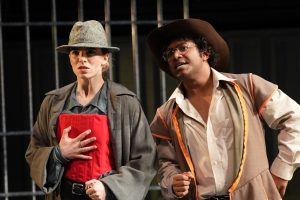

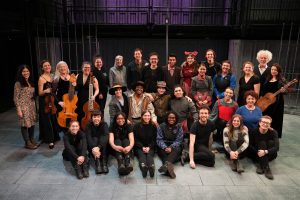
No Comments